On January 24, 1923, the first radio network was born when WEAF in New
York fed a broadcast of a concert to WNAC in Boston through the
telephone lines. Owned by AT&T, the network grew to more than twenty
stations with WEAF as the flagship station. Within a year, RCA, GE,
and Westinghouse organized a rival network with WJZ in New York as the
flagship station, using telegraph lines to connect its stations to
avoid AT&T's exorbitant fees for the use of its telephone lines.
Telegraph wires, however, resulted in poor sound quality for many of
the broadcasts. Selling commercial time provided financial support to
run the fledgling networks, although the RCA network chose instead to
rely on income generated from the sale of radio receivers.
|
| |
|
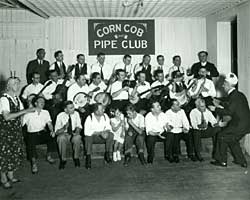
|
 |
|
By the 1930s, WRVA's
main "traditional" music show was the Corn Cob Pipe Club. Based in
fictional "Virginia Cross Roads," the show incorporated an
orchestrated patter of jokes, popular and traditional sons, and even a
minstrel duo (Sawdust and Moonshine). The Corn Cob Pipe Club boasted
more than 272,000 members nationwide by 1934 with chapters in all
forty-eight states.
|
The Corn Cob Pipe Club published a
monthly magazine, Smoke, that included jokes, news from
Virginia Cross Roads, columns by "Squire Hix" and emcee Pat Binford,
and listings of clubs.
Smoke, Aunt Sarah. |
|
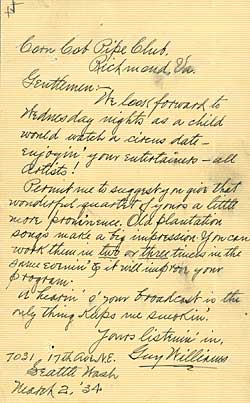
Larger View |
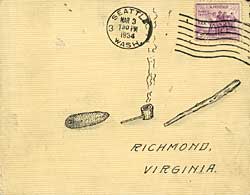
|
|
Guy Williams was a regular listener to the Corn Cob Pipe Club who sent
this letter of appreciation in an imaginatively addressed envelope.
Amazingly, the letter reached its destination!
Letter from Guy Williams, Seattle, to Corn Cob Pipe Club, Richmond.
March 2, 1934. |
| |
Despite success in the radio network business, AT&T transferred its
radio interests to a separate company, the Broadcasting Company of
America, for the sole purpose of selling it. After intense
negotiations, RCA bought the Broadcasting Company of America and its
flagship station WEAF for one million dollars and created the National
Broadcasting Company (NBC), which made its debut broadcast on November
15, 1926. NBC operated as two networks. With WEAF as the flagship
station , the NBC Red network aired commercial broadcasts and
higher-rated programs to attract advertisers. The NBC Blue network,
with WJZ as the flagship station, broadcast speeches, cultural and
educational programs, and public relations programs.
Other networks followed. On September 18, 1927, a new network began
broadcasting. The United Independent Broadcasters (UIB) and the
Columbia Phonograph Company organized the Columbia Phonograph
Broadcasting System (CPBS). UIB and CPBS merged in 1929 under the
leadership of William Paley to form the Columbia Broadcasting System
(CBS). The Mutual Broadcasting System (MBS) was established in 1934
when WGN in Chicago and WOR in New York partnered with WXYZ in Detroit
and WLW in Cincinnati to sell advertising. MBS offered "cooperative
advertising," the forerunner of syndication. Programming was
distributed among affiliate stations rather than from a central
production center. MBS was the only major radio network not to venture
into television. In 1941, the Federal Communications Commission (FCC),
established in 1934, accused NBC of being a monopoly and forced the
company to sell one of its networks. NBC sold the Blue Network in 1943
to Edward Noble, a candy manufacturer, who changed the name to the
American Broadcasting Company (ABC).
|
| |
|
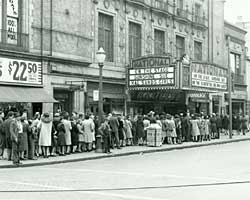 |
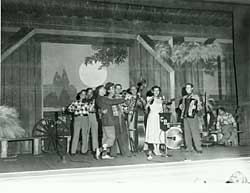 |
|
The Old Dominion Barn Dance, a
country music variety show, began in 1946 with Mary Higdon "Sunshine
Sue" Workman and her husband, John Workman, as hosts. The show ran
until 1957 and made Sunshine Sue a star as she was anointed "Queen of
the Hillbillies." Broadcast from the Lyric Theater on the corner of
9th and Broad Streets, it featured such performers as the Carter
Sisters, Grampa Jones and Ramona, The Saddle Sweethearts, Crazy Joe
Maphis, the Tobacco Tags, Quincy Snodgrass, Toby Stroud, Buster
Puffenbarger, Curly Collins, Benny Kissinger, Little Robert, Chet
Atkins, and Earl Scruggs. Every third Saturday of the month, it was
broadcast coast-to-coast on CBS.
Old Dominion Barn Dance |
| |
The financial pressures of the Great Depression during the 1930s
forced unaffiliated stations to join networks to survive. Networks
provided local stations the ability to broadcast national events and
programs and receive money from national sponsors. National network
radio brought events happening thousands of miles away into the living
rooms of almost every American and helped unite a nation. During this
"golden age" of the 1930s and 1940s, national network radio kept
Americans informed, entertained, and diverted from the hardships of
depression and war.
|
|
|
|